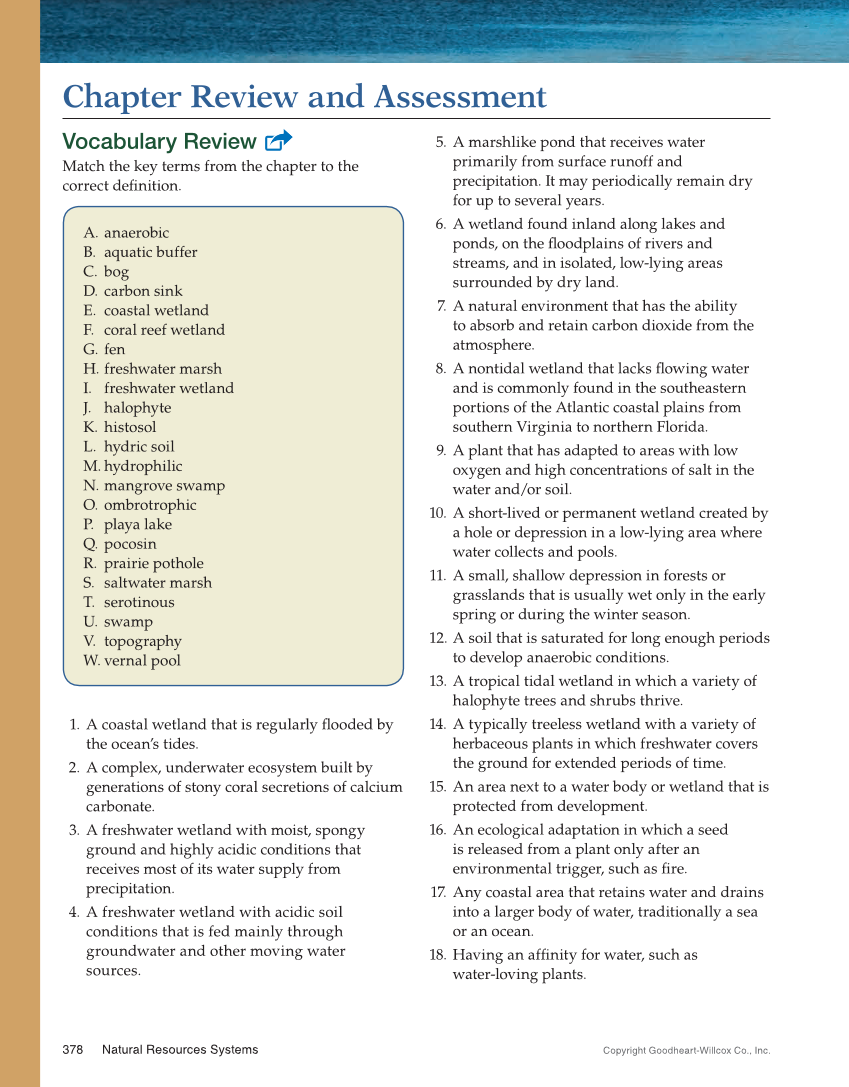378 Natural Resources Systems Copyright Goodheart-Willcox Co., Inc. Chapter Review and Assessment Vocabulary Review Match the key terms from the chapter to the correct defi nition. A. anaerobic B. aquatic buffer C. bog D. carbon sink E. coastal wetland F. coral reef wetland G. fen H. freshwater marsh I. freshwater wetland J. halophyte K. histosol L. hydric soil M. hydrophilic N. mangrove swamp O. ombrotrophic P. playa lake Q. pocosin R. prairie pothole S. saltwater marsh T. serotinous U. swamp V. topography W. vernal pool 1. A coastal wetland that is regularly fl ooded by the ocean’s tides. 2. A complex, underwater ecosystem built by generations of stony coral secretions of calcium carbonate. 3. A freshwater wetland with moist, spongy ground and highly acidic conditions that receives most of its water supply from precipitation. 4. A freshwater wetland with acidic soil conditions that is fed mainly through groundwater and other moving water sources. 5. A marshlike pond that receives water primarily from surface runoff and precipitation. It may periodically remain dry for up to several years. 6. A wetland found inland along lakes and ponds, on the fl oodplains of rivers and streams, and in isolated, low-lying areas surrounded by dry land. 7. A natural environment that has the ability to absorb and retain carbon dioxide from the atmosphere. 8. A nontidal wetland that lacks fl owing water and is commonly found in the southeastern portions of the Atlantic coastal plains from southern Virginia to northern Florida. 9. A plant that has adapted to areas with low oxygen and high concentrations of salt in the water and/or soil. 10. A short-lived or permanent wetland created by a hole or depression in a low-lying area where water collects and pools. 11. A small, shallow depression in forests or grasslands that is usually wet only in the early spring or during the winter season. 12. A soil that is saturated for long enough periods to develop anaerobic conditions. 13. A tropical tidal wetland in which a variety of halophyte trees and shrubs thrive. 14. A typically treeless wetland with a variety of herbaceous plants in which freshwater covers the ground for extended periods of time. 15. An area next to a water body or wetland that is protected from development. 16. An ecological adaptation in which a seed is released from a plant only after an environmental trigger, such as fi re. 17. Any coastal area that retains water and drains into a larger body of water, traditionally a sea or an ocean. 18. Having an affi nity for water, such as water-loving plants.
